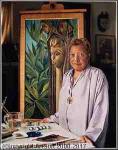Lois Mailou Jones
Lois Mailou Jones
Place: Boston
Born: 1905
Death: 1998
Biography:
Loïs Mailou Jones was an influential artist and teacher during her seven-decade career. Jones was one of the most notable figures to attain notoriety for her art while living as a black expatriate in Paris during the 1930s and 1940s. Her career began in textile design before she decided to focus on fine arts. Jones looked towards Africa and the Caribbean and her experiences in life when painting. As a result, her subjects were some of the first paintings by an African-American artist to extend beyond the realm of portraiture. Jones was influenced by the Harlem Renaissance movement and her countless international trips. Lois Mailou Jones' career was enduring and complex. Her work in designs, paintings, illustrations, and academia made her an exceptional artist that continues to receive national attention and research.
Loïs Mailou Jones was born in Boston, Massachusetts, to Thomas Vreeland and Carolyn Jones. Her father was a building superintendent who later became a lawyer after becoming the first African-American to earn a law degree from Suffolk Law School. Her mother worked as a cosmetologist. During her childhood, Jones' parents encouraged her to draw and paint using watercolors. Her parents bought a house on Martha's Vineyard, where Jones met those who influenced her life and art, such as sculptor Meta Warrick Fuller, composer Harry T. Burleigh, and novelist Dorothy West.
From 1919 to 1923, Jones attended the High School of Practical Arts in Boston. During these years, she took night classes from the Boston Museum of Fine Arts through an annual scholarship. Additionally, she apprenticed in costume design with Grace Ripley. She held her first solo exhibition at the age of seventeen in Martha's Vineyard. Jones began experimenting with African mask influences during her time at the Ripley Studio. From her research of African masks, Jones created costume designs for Denishawn. :178
From 1923 to 1927, Jones attended the School of the Museum of Fine Arts in Boston to study design, where she won the Susan Minot Lane Scholarship in Design yearly. She took night courses at the Boston Normal Art School while working towards her degree. After graduating from the School of the Museum of Fine Arts, she received her graduate degree in design from the Design Art School of Boston in 1928. Afterwards, she began working at the F. A. Foster Company in Boston and the Schumacher Company in New York City. During the summer of 1928, she attended Harvard University where she decided to focus on painting instead of design.
Jones continued taking classes throughout her lifetime. In 1934, she took classes on different cultural masks at Columbia University. In 1945, she received a BA in art education from Howard University, graduating magna cum laude.
Jones’ career began in the 1930s and she continued to produce art work until her death in 1998 at the age of 92. Her style shifted and evolved multiple times in response to influences in her life, especially her extensive travels. She worked with different mediums, techniques, and influences throughout her long career. Her extensive travels throughout Europe, Africa, and the Caribbean influenced and changed how she painted. She felt that her greatest contribution to the art world was "proof of the talent of black artists". She wished to be known as an American painter with no labels. Her work echoes her pride in her African roots and American ancestry.
Jones’ teaching career began shortly after finishing college. The director of the Boston Museum School refused to hire her, telling her to find a job in the South where "her people" lived. :186 In 1928 she was hired by Charlotte Hawkins Brown after some initial reservations, and subsequently founded the art department at Palmer Memorial Institute in North Carolina. As a prep school teacher, she coached a basketball team, taught folk dancing, and played the piano for church services. In 1930, she was recruited by James Vernon Herring to join the art department at Howard University in Washington, D.C., Jones remained as professor of design and watercolor painting until her retirement in 1977. She worked to prepare her students for a competitive career in the arts by inviting working designers and artists into her classroom for workshops. While developing her own work as an artist, she became an outstanding mentor and strong advocate for African-American art and artists. :13 14 15 16
In the early 1930s, Jones began to seek recognition for her designs and art work. She began to exhibit her works with the William E. Harmon Foundation with a charcoal drawing of a student at the Palmer Memorial Institute, Negro Youth (1929). In this period, she shifted away from designs and began experimenting with portraiture. :25
Jones developed as an artist through visits and summers spent in Harlem during the onset of the Harlem Renaissance or New Negro Movement. Aaron Douglas, a Harlem Renaissance artist, influenced her seminal art piece The Ascent of Ethiopia. African design elements can be seen in both Douglas and Jones' paintings. Jones studied actual objects and design elements from Africa. :193
More...
Wikipedia link: Click Here














